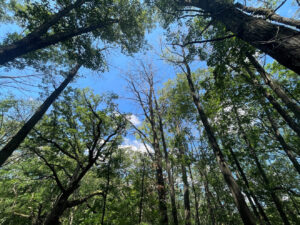
An oak tree (center) that died rapidly from oak wilt during the summer of 2024. / Photo Credit: Wisconsin DNR
By Michael Hillstrom, Wisconsin DNR Forest Health Specialist
Michael.Hillstrom@wisconsin.gov or 608-513-7690
Oak wilt symptoms typically begin to appear in southern Wisconsin in late June and in northern Wisconsin during July.
Watch for browning leaves, starting at the top of the canopy and progressing downward. Most leaves will fall from infected trees as they die, typically within two to four weeks.
During the high-risk oak wilt period (from April through July), you may also see bark cracks with pressure pads behind them on oak trees that died from oak wilt during summer or fall 2024.
Several management methods are effective at containing oak wilt pockets. Pockets are easiest to contain, and most successful, when there are only a few diseased trees, so early detection and diagnosis are important.
If you need help diagnosing oak wilt in your forest, contact your local Wisconsin Department of Natural Resources Forest Health specialist.
If you have a question about testing yard trees, please contact the Plant Disease Diagnostic Clinic at the University of Wisconsin-Madison for sample testing (for a fee) or contact a certified arborist.
Oak wilt is not the only issue impacting oaks, so getting an official diagnosis is important. Individually or in combination, issues such as twolined chestnut borer, Armillaria, defoliators including spongy moth and oak leafroller and abiotic issues such as drought can also cause oak mortality that may resemble oak wilt.
